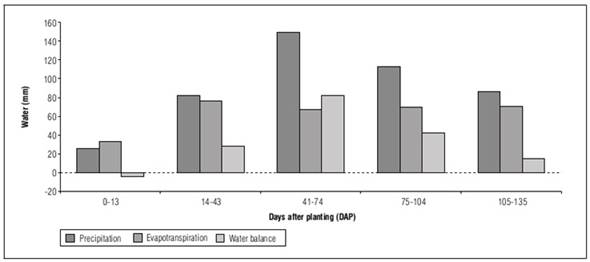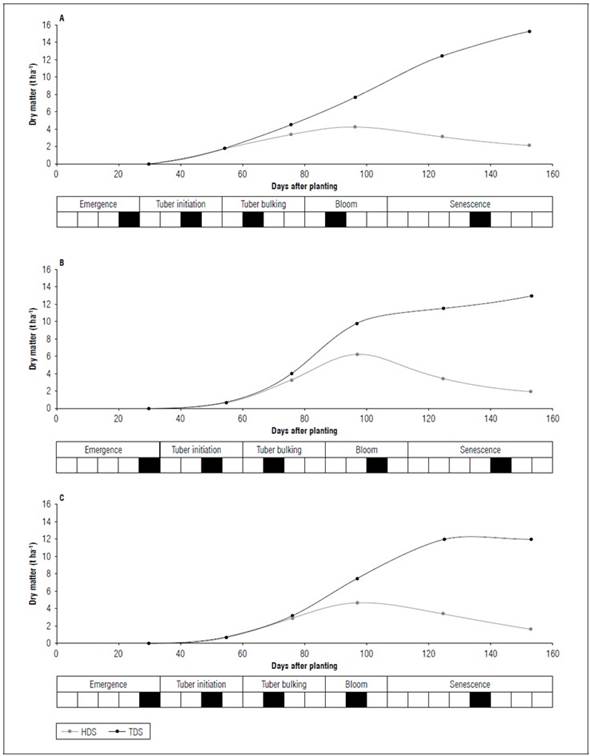INTRODUCTION
Potato (Solanum tuberosum L.) is the third most important food crop worldwide due to its efficiency in calorie production per unit and water use (Hill et al., 2021). This crop is economically valuable for both developed and developing countries because the global harvest reached about 359 million tons in 2020 (FAO, 2022), being not only a source of food but also of employment and income. In Colombia, potato production is the agricultural activity that employs 90,000 rural families located in about 130,000 ha concentrated in the departments of Cundinamarca, Boyaca, Nariño and Antioquia (90%) (MADR, 2019), in addition to being small farms located on the high Andean mountain range (67%) (Núñez et al., 2018). The impact of climate change due to the reduction in water supply and increase in temperature in the region not only aggravates the proliferation of pests and the severity of diseases but also the demand for irrigation, since estimates in Andean agriculture show elevations and reductions in local temperature, evapotranspiration potential, variations in precipitation, and water shortages at critical times for its development that will affect potato cultivation (Lozano-Povis et al., 2021).
The management of farming practices has a significant effect in the performance of the crops and the sustainability of natural resources (Zhang et al., 2021). Due to potato's superficial root system or shallow roots it is highly susceptible to water deficit, and tillage together with irrigation guarantees the best hydrothermal properties of the soil (Hou and Li, 2019; Hill et al., 2021). The study of management practices takes on great relevance, as it establishes the interactions of environmental resources in the face of local climatic variations, regional and global influence on the physiological process of the crop (Hall and Sadras, 2009; Andrade et al., 2012), thus guiding the choice of more appropriate practices (Djaman et al., 2022), increasing the demand for irrigation infrastructure, generating higher costs and possibly lower yields when weather conditions are extreme or adverse (Hill et al., 2021).
Water is one of the most important factors for plant development, and its deficiency is one of the main sources of stress. Water deficit is one of the factors that significantly affects crop production, which can lead to crop death, and produce a negative effect on the quantity and quality of yield (Djaman et al., 2021). According to Hill et al. (2021), the lack of research on the response of potato to drought from plant morphophysiology is outdated and there is no consensus to explain the plant's response to drought since it is a modern crop that has not been selected to be tolerant to water stress.
Agricultural production must be based on sustainability, and this requires the conservation of natural resources, including the efficient use of water and soil quality (Vélez-Sánchez et al., 2023). Soil as a heterogeneous substrate generates a fundamental medium for the growth of any agricultural production system (Sarangi et al., 2021). Soil degradation due to erosion and compaction is very frequent in potato cultivation due to tillage (Djaman et al., 2022), irrigation system and water management (Djaman et al., 2021).
According to Zhang et al. (2021), better potato crop performance has been observed when changes are made in planting type, mulching use, and tillage (Hou and Li, 2019), but as pointed out by Djaman et al. (2022) no consistent results are found in the use of conservation tillage and efficient water use according to the irrigation system (Djaman et al., 2021). Therefore, this research evaluated the interrelationships between the growth and development of potato crops associated with the irrigation and tillage system in conditions of the Andean zone of Colombia.
MATERIALS AND METHODS
The study was conducted between March and August 2021 in Siachoque (Colombia) at 5.527 N, -73.216 W and altitude of 2,812 m a.s.l. The study area is characterized by a cold dry climate (Caldas-Lang classification), annual precipitation of 935 mm, annual temperature of 13.2°C, and minimum and maximum temperatures of 6.8°C and 17.6°C, respectively. During the study period, the maximum temperature was 17.5°C (range 13.3-20.9°C) and the minimum temperature was 7.8°C (range 3.8-10.9°C); average radiation was 3,775.8 W m-2. On the other hand, precipitation was 545.8 mm (being the most abundant in May and June).
The taxonomic classification of the soil is Typic Haplustepts (USDA, 2010), of sedimentary origin, deep, well drained, clay loam texture - FAr and the physical-chemical characterization presents contents of 1.41% organic matter (Walkley-Black), 159 mg kg-1 phosphorus (Bray II - colorimetry), 0.99 cmol+ kg-1 potassium (NH4 Ac -atomicabsorption extraction) and pH 5.45 (ratio 1:1 in water). The slope of the land is 3-12% and the previous crop was pasture.
The Pastusa Superior variety was used with a planting density of 0.40 m per site and 0.90 m between rows. A crossed block experimental design was established with two factors, tillage and irrigation system, together with a control without irrigation for a total of five treatments. Conventional tillage consisted of two passes with one-way disc plough and one pass with a horizontal rotavator. Conservation tillage consisted of two passes with one-way disc plough and one pass with a vertical rotavator. Irrigation requirements were supplemented with 26.4 mm in the sprinkler system and 79.3 mm in the drip irrigation system.
Edaphic fertilization was fractioned in two moments, at sowing and 50 days after planting (DDP) for the sprinkler irrigation treatments with N, P2O5, and K2O (kg ha-1) ratio of 173, 258 and 173, respectively. In the case of drip irrigation, edaphic fertilization was applied at planting with N, P2O5, and K2O (kg ha-1) with 57, 85, and 57, followed by fertigation from 30 to 50 DDP with N, P2O5, and K2O (mg kg-1) with 130, 85, and 120 (mg kg-1) and, from 50 to 100 DDP with 120, 65, and 190 (mg kg-1). A total of 16 fertigation applications were made during the crop cycle. The main disease problem was Phytophthora infestans, which was effectively controlled by the application of chlorothalonil, dimethomorph, mancozeb, cymoxanil and metalaxyl. In insect pests, Tecia solanivora presented the greatest limitation, and its population was controlled using thiamethoxam, cyantraniliprole and imidacloprid.
Bulk density (cylinder), total porosity (indirect - formula) and dry aggregate distribution (Shaker-sieve, Ro-Tap, model RX-29) were evaluated at three times in the soil: before and after tillage and before harvest. Measurements were also made at 55, 76, 97, 125 and 153 DDP of transpiration (E); net photosynthesis or CO2 assimilation rate (A); intercellular CO2 concentration (Ci); stomatal conductance (gsw); electron transport rate (ETR); photochemical quenching (qP); intrinsic water use efficiency (UEA_i) and transpiration use efficiency (UEA_E) with the portable photosynthesis system LI-COR model LI-6800 equipment on two plants per experimental unit, verifying that the leaves were free of disease, pests, pesticide residues, dew or water droplets; measurements were made on two leaflets of a leaf located in the external center of the lower stratum of the plant (33% of height at the time of measurement) and on two leaflets of a leaf located in the external center of the upper stratum of the plant (66% of height at the time of measurement). In addition, plant fresh and dry mass, and yield were determined. Water productivity was evaluated using the methodology of Escalona et al. (2003) by relating the amount of dry matter produced per unit of water consumed (Eq. 1).
For the statistical analysis, an ANOVA analysis of variance and Tukey's multiple comparison test for main effects (tillage and irrigation) were performed. The data were processed with the R-Studio software, version 1.4.1106.
RESULTS AND DISCUSSION
The climatic conditions presented a positive balance in the natural water supply measured by precipitation, in most of the time of the productive system and with lower availability at the beginning and end (Fig. 1).
Potato is extremely sensitive to drought generating physiological, biochemical and molecular alterations in the plant (Hill et al., 2021), it is a great challenge its production at a global level since, as pointed out by Gervais et al. (2021), climate change will expose crops to both greater severity and frequency of drought. Although modern potato cultivars are very productive in generating calories from water use mainly by a shallow rooting system (Hill et al., 2021), new cultivars tolerant to multiple stressful conditions such as prolonged and frequent droughts and heat waves are required (Gervais et al., 2021; Zhang et al., 2022).
Yield components
Marketable yield, including the size categories first (diameter > 4 cm, ≤ 6 cm) and second (diameter > 2 cm, ≤4 cm), only showed significant differences with irrigation system (Fig. 2).
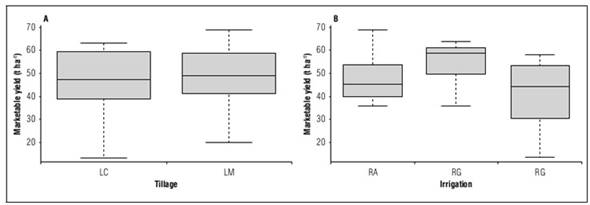
Figure 2. Marketable yield (t ha-1) of potato under conventional tillage (LC) and conservation tillage (LM), sprinkler irrigation (RA) and drip irrigation (RG) and no irrigation (RT).
The high response of potato to irrigation (Djaman et al., 2021) was observed in the drip irrigation system which presented the highest commercial yield (54.67 t ha-1), followed by sprinkler irrigation (47.72 t ha-1), while the absence of irrigation presented the lowest yield (40.72 t ha-1). According to King et al. (2020) potato requires an irrigation system capable of light, frequent and uniform water application. According to Agronet (2024) the average yield for the Department Boyaca for the year 2022 was 20.85 t ha-1, the results with drip irrigation were higher by 33.85 t ha-1, sprinkler irrigation 26.87 t ha-1 and without irrigation 19.87 t ha-1.
The differences between irrigation treatments in potato yield showed marked differences with 13.96 t ha-1 between drip and no irrigation and 7 t ha-1 between drip and sprinkler, and sprinkler with no irrigation. As pointed out by Djaman et al. (2021 and 2022), given the sensitivity of potato to water deficit at all stages of the crop, a constant supply of water and nutrients is required, generating greater assimilation and consequently good leaf development, a situation that coincides with the results of Ñústez et al. (2009), in different potato varieties that the greater the development of the photosynthetic apparatus (foliage), the greater the accumulation of dry matter in leaves; they also indicate that the assimilation of dry matter and its distribution within the plant are processes that determine the productivity of the crop, as well as the environmental conditions. Likewise, Guerrero et al. (2020) compared drip and sprinkler irrigation in the cv. Diacol Capiro, finding higher yield and water use in drip irrigation.
Total dry matter production is the result of the efficiency with which the crop leaves capture and use the available solar radiation during the growth cycle; the potato plant under drought can adjust the size of the photosynthetic apparatus as a protective measure by decreasing the amount of solar radiation, the photosynthetic amount of leaves, leaf area index, plant structure, among others (Gervais et al., 2021; Hill et al., 2021). The highest accumulation of total and harvestable dry matter was found in the drip irrigation treatment (Fig. 3) because of the fertigation applied, which allows a better supply of water and nutrients to the crop. This direct contribution to the soil volume explored by the roots maximizes nutrient use efficiency and minimizes over-fertilization and water losses (Kafkafi and Tarchitzky, 2012). It was also observed by Guerrero et al. (2020) in 'Diacol Capiro' under similar experimental conditions.
Tillage effect
Although no significant differences were found between tillage types for yield, conservation (48.73 t ha-1) and conventional (46.67 t ha-1), neither in the evaluated soil parameters (Tab. 1) nor in the physiological variables of the plant (data not shown). The tillage system favors the conditions for the initial growth of the potato crop, and although there are no significant statistical differences in bulk density, porosity and mean weighted diameter (WMD) of aggregates between treatments, characteristics that were maintained at the time of harvest in all treatments (Tab. 1), it can be noted that high values of bulk density indicate compaction, being higher before tillage, as the total porosity is lower before tillage and increases with tillage (conventional and conservation), the DPM of the aggregates is favored with conservation tillage.
Table 1. Physical characteristics of the analyzed soil.
| Time | Type of tillage | Bulk density (g∙cm-1) | Total prosity (%) | Weighted acerage diameter (DPM) aggregates (mm) |
|---|---|---|---|---|
| Before the tillage | 1.71 a | 35.39 a | 2.90 a | |
| After the tillage | Conservation | 1.53 a | 42.18 a | 3.25 a |
| Conventional | 1.51 a | 42.76 a | 2.65 a | |
| Before the harvest | Conservation | 1.47 a | 44.55 a | 3.51 a |
| Conventional | 1.44 a | 45.42 a | 3.12 a | |
Depth between 0-20 cm. Means with equal letters between rows do not indicate significant differences according to Tukey's test (P≥0.05).
Tillage is the practice of mechanically manipulating the soil using soil preparation implements, with the objective of altering its structure and decreasing resistance to root penetration, generating an appropriate medium for seed germination and rapid root establishment (Djaman et al., 2022). According to King et al. (2020), the shallow root system of potato reaches 30 and maximum 60 cm; this inability of the plant is exacerbated by machinery management practices that generate layers of compaction due to high machinery traffic and type of tillage in inadequate moisture conditions. Conservation tillage is any soil preparation practice that seeks to have as little impact as possible with mechanical implements in its tillage as a form of conservation and thus create conditions for seed germination and subsequent plant development and growth (Zhang et al., 2021). On the contrary, excessive mechanization can lead to deformations of the structure, compaction of sub-surface layers and changes in moisture availability in the root zone of cultivated plants (Hou and Li, 2019).
According to Hou and Li (2019) tillage favors hydrothermal conditions to the soil for good growth and tuberization of potato but causes susceptibility of soils to runoff erosion which is directly related to the stability of soil surface aggregates, also Djaman et al. (2022) mention that with a conventional type tillage system reduces carbon and nitrogen contents by the removal of the cover looking for weed control in potato crop. In research by Garcia et al. (2018) conservation tillage favors the population of fungi and bacteria, which leads to an improvement in the physical properties of soils, and with conventional tillage the organic matter content is reduced reducing the stability of soil aggregates (Pagliai et al., 2004; Djaman et al., 2022) as supported in this study. Proper soil management is the turning point for understanding the mechanisms governing processes such as soil energy exchanges, water cycling and hence plant growth (Hou and Li, 2019; Djaman et al., 2021; Zhang et al., 2021).
Photochemical energy capture performance variables
Net photosynthesis or CO2 assimilation rate, transpiration, intercellular CO2 concentration, stomatal conductance, intrinsic water use efficiency and transpiration use efficiency showed significant differences (P<0.05) for the effect of irrigation systems and control treatment, and are related to the performance in photochemical energy use and water use efficiency (Tab. 2) and are analyzed below.
Table 2. Effect of irrigation system on physiological variables of potato.
| Type of irrigation | E (mmol H2O m-2 s-1) | A (μmol CO2m-2 s-1) | Ci (μmol CO2m-2 s-1) | gsw (mol H2O m-2 s-1) | UEA_i A/gsw (μmol CO2 /mol H2O) | UEA_E A/E (μmol CO2 /mmol H2O) |
|---|---|---|---|---|---|---|
| RA | 5.07 a | 19.93 b | 328.59 a | 0.61 a | 33.52 b | 4.16 b |
| RG | 5.15 a | 20.82 a | 320.39 b | 0.59 a | 37.2 a | 4.92 a |
| RT | 4.72 b | 19.15 b | 322.29 ab | 0.55 b | 36.12 ab | 4.46 b |
| P valor | * | * | * | * | * | * |
RA: sprinkler irrigation; RG: drip irrigation; RT: no irrigation; E: transpiration; A: net photosynthesis or CO2 assimilation rate; Ci: intercellular CO2 concentration; gsw: stomatal conductance; UEA_i: intrinsic water use efficiency, UEA_E: transpiration use efficiency. * significant differences, P<0.05. Means with different letters indicate significant differences according to Tukey's test (P<0.05).
Transpiration rate (water outflow from the plant) and net photosynthesis are physiological parameters that respond to soil water deficit and air vapor pressure that determine potato plant performance and degree of sensitivity to drought (Zhang et al., 2022). The non-irrigation treatment showed the lowest transpiration (Fig. 4) affecting biomass production (Fig. 3) and yield due to lower photosynthesis (Fig. 2 and 4B) in most observations. It was also observed that as senescence begins, both transpiration and photosynthesis are minimized and thus biomass accumulation (Fig. 4).
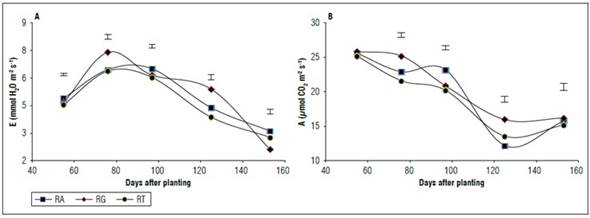
Figure 4. Transpiration (E) and net photosynthesis or CO2 assimilation rate (A) in potato under sprinkler and drip irrigation.
Chemical signaling with hormones such as abscisic acid (ABA) produced from the root, has been observed as a regulator of gas exchange through stomatal opening (Zhang et al., 2022), but depending on the frequency and intensity of drought, genes associated with protection related to stress factors such as frost and salinity are expressed (Hill et al., 2021), even evaluations in cultivars classified as drought tolerant have adaptive mechanisms such as foliage reduction, osmoprotective compounds (proline) and genes related to osmotic adjustment and membrane stability (Gervais et al., 2021). The times of greatest effect of drought on yield are considered to be early foliage formation and tuberization (Djaman et al., 2021; Gervais et al., 2021; Hill, 2021; Zhang et al., 2022).
Transpiration (E) was higher in most observations made with irrigated treatments, with drip irrigation standing out (Fig. 4). According to King et al. (2020), drip irrigation is preferred for commercial potato cultivation, although all irrigation systems are used according to their cost. Irrigated treatments showed the highest net photosynthesis or CO2 assimilation rate (A) versus no irrigation. This difference was due to changes in soil moisture contents since the drip treatment presented the highest volumetric soil moisture between 40.4 and 62.3%, sprinkler irrigation 32.1 and 55.2% and no irrigation 23.8 and 41.5%.
Vapor pressure deficit is the driving force behind transpiration but the shallow root system of potato makes it a tall plant very sensitive to drought which strongly inhibits physiological and biochemical processes leading to poor plant performance affecting yield, mainly by inhibition of photosynthesis due to drought-induced stomatal closure which aims to reduce transpiration water loss and conserve plant water status but limits CO2 diffusion in the leaf affecting the Calvin cycle (Gervais et al. , 2021; Hill 2021; Zhang et al., 2022), which explains the high performance of the drip irrigation treatment that showed superiority in transpiration and net photosynthesis or CO2 assimilation rate in the five measurements performed in the crop cycle and showed the highest yield (Fig. 2) and total dry matter accumulation (Fig. 3).
The intercellular CO2 concentration (Ci) was similar among irrigation treatments and from 110 DDS onwards, sprinkler irrigation was superior (Fig. 5A). According to Zhang et al. (2022), C3 plants such as potato showed an increase in intercellular CO2 (Ci) in leaves when faced with high CO2 concentration in the air, but limitations in CO2 diffusion through intercellular spaces, cell walls and membranes of mesophyll cells and chloroplasts responded differentially to environmental stresses such as heat. The results did not show differences since King et al. (2020) point out that evaporation of water from the leaf cools the canopy temperature.
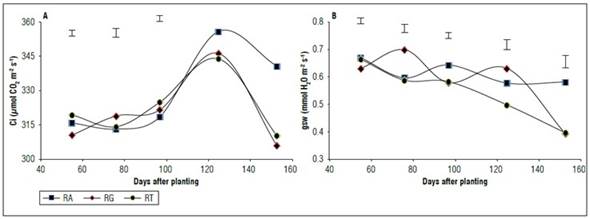
Figure 5. Intercellular CO2 concentration (Ci) and stomatal conductance (gsw) in potato under different irrigation systems.
The behavior of stomatal conductance was higher in treatments with irrigation systems for most of the observations made (Fig. 5B). Stomatal conductance determines the opening of the stomata and drought stress significantly suppresses this parameter, which is lower in the treatment without irrigation (Fig 5B). Gervais et al. (2021) compared different genotypes with differential behavior to drought showing that all were affected with a reduction in stomatal conductance between 90-80% in tolerant genotypes, 70-80% for moderately tolerant and 50% for sensitive genotypes compared to their counterparts well watered. On the other hand, King et al. (2020) point out that only a 10% deviation from the optimal water application affects potato yield and according to our observations, the drip irrigation treatment presented the highest volumetric water contents in the soil, the highest yield (Fig. 2), total dry matter accumulation (Fig. 3), transpiration and net photosynthesis or CO2 assimilation rate (Fig. 4) in most observations during the production cycle. Likewise, Hill et al. (2021) consider that the sensitivity to drought of modern potato genotypes is due to leaving aside those genotypes with small canopies that have lower evapotranspiration and high harvest index, open stems and better light penetration, and even genotypes with little deep with dense roots for greater water absorption. The lower stomatal conductance limits gas exchange and the availability of CO2 for photosynthetic assimilation, in addition, it is measured by chemical regulation such as the production of abscisic acid at the tip of potato roots that travels through the xylem and increases with slight water deficits in the soil (Gervais et al., 2021).
Efficient use of water
The efficiency of water use, intrinsic and transpiration, did not present major differences between treatments under different irrigation systems (Fig. 6). These parameters relate gas exchange through water output (stomatal conductance or transpiration) and net photosynthesis (CO2 assimilation). The water use efficiency of transpiration relates CO2 assimilation/transpiration (A/E, µmol CO2/mol H2O) and intrinsic water use efficiency CO2 assimilation/stomatal conductance (A/gsw, µmol CO2/ mol H2O). The same behavior was observed in the treatments for the efficiency of transpiration water use and the drip irrigation and absence of irrigation treatments in the efficiency of intrinsic water use. The sprinkler irrigation treatment presented differences between three of the five measurements compared to the efficiency of intrinsic water use. Gervais et al. (2021) reports a similar response in the efficiency of water use of transpiration in genotypes with tolerance, moderate tolerance and sensitivity to drought (25-35% of well-watered treatments), suggesting that the differences in performance between these genotypes are not were associated with the differences with this parameter but in the physiological and biochemical phenomena of the plant. On the other hand, Zhang et al. (2022) evaluated drought stress simultaneously with heat stress, finding an interaction differentially with different vapor pressure deficits in potatoes. The water deficit in the soil limited the gas exchange in the leaf, the accumulation of dry matter of the cannopi, the efficiency of water use and increases the concentration of abscisic acid in the xylem and the leaf for all levels of pressure of steam evaluated. Furthermore, they observed that a high vapor pressure deficit reduces stomatal conductance, but increases transpiration, and a higher threshold in soil water content to maximize these parameters (greater than 80% breathable water). Due to the above, the behavior of stomatal conductance and therefore the efficiency of intrinsic water use is dependent on temperature due to the varied response to abscisic acid, and a modification of the climatic conditions in the cannopi is possible for the treatment by sprinkler irrigation (Fig. 6A).
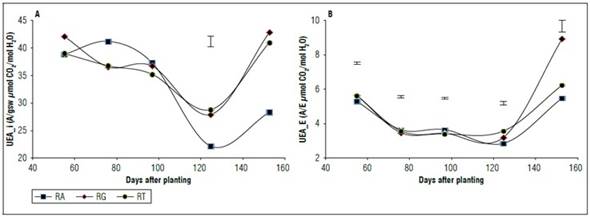
Figure 6. Intrinsic water use efficiency (UEA_i) and transpiration efficiency (UEA_E) in potato under different irrigation systems. RA: sprinkler irrigation; RG: drip irrigation; RT: no irrigation.
The observations of Zhang et al. (2022) about vapor pressure deficit and transpirable water contents in potato confirm that the differences between intrinsic and transpiration water use efficiency depend on species and variety-specific characteristics, with physiological, biochemical and molecular mechanisms independent of leaf gas exchange as reported by Hill et al. (2021), since it is not only dependent on soil water contents. Moreover, potato is highly water efficient (Djaman et al., 2021) maximizing net photosynthesis (CO₂ assimilation rate) at the rate of transpiration possible, showing uniformity in response independent of the irrigation system evaluated (Fig. 6B) (Gervais et al., 2021).
In agreement with the above, the water productivity results presented similar responses in the evaluated irrigation systems (Tab. 3). However, it is observed that drip irrigation increases yield and water productivity with respect to the other treatments. King et al. (2020) mention that potato is grown under all types of irrigation systems worldwide. For the experimental conditions, rainfall was above normal in three of the five months of the production cycle and despite the available water supply from rainfall, the absence of irrigation presented the lowest yield and water productivity. Djaman et al. (2021) described a water demand for high yielding potato between 500 to 700 mm according to our results of 546 to 625 mm. Likewise, a water productivity between 7.46-8.74 kg tubers/m3 of water and the results of water quantity found were between 6 to 11.6 m3 ha-1, with drip irrigation surpassing the other treatments in all cases (Tab. 3).
Table 3. Water productivity in potato under different irrigation systems.
| Type of irrigation | Yield (kg ha-1) | Water sheet (mm) | Amount of water (m³ ha-1) | Water productivity (kg tubers/m3 water) |
|---|---|---|---|---|
| Sprinkler | 47,725.37 a | 572.20 a | 5,722.00 a | 8.34 a |
| Drip | 54,677.25 a | 625.16 a | 6,251.60 a | 8.75 a |
| Absence of irrigation | 40,720.13 a | 545.80 a | 5,458.00 a | 7.46 a |
Means with equal letters between rows in each column indicate no statistical difference Tukey test (P<0.05).
Soil moisture control is a challenge for commercial potato production that requires irrigation in many areas of the world (King et al., 2020). Given the uncertainty in water supply caused by climate change, the sensitivity of potato to drought due to its shallow root system makes constant evaluation of irrigation systems necessary, as Djaman et al. (2021) emphasize that research results in irrigation management are not transferable from one place to another due to the differences between genotypes and the agroclimatic characteristics of the producing areas. Drip irrigation can be an important option in dry Andean areas where potatoes are grown to improve water productivity.
CONCLUSIONS
Potato cultivation in the high Andean zone of Colombia requires water supplementation through irrigation. The types of tillage did not achieve statistical differences in potato crop yield and soil variables; however, conservation tillage can be recommended to improve the physical variables of high Andean soils planted with potato. Drip irrigation increased the yield of potato cv. Pastusa Superior by 25.53% compared to no irrigation. Despite the sensitivity of potato to drought due to a superficial root system, it was observed that water productivity may be favored with drip irrigation due to a higher performance in water use efficiency. In addition, the effect of drip irrigation accumulated greater dry matter and overall physiological performance was favored over sprinkler irrigation and the control treatment. Yields exceeded 59% of the official figures for the study area due to the availability of drip irrigation and the use of this technology.














